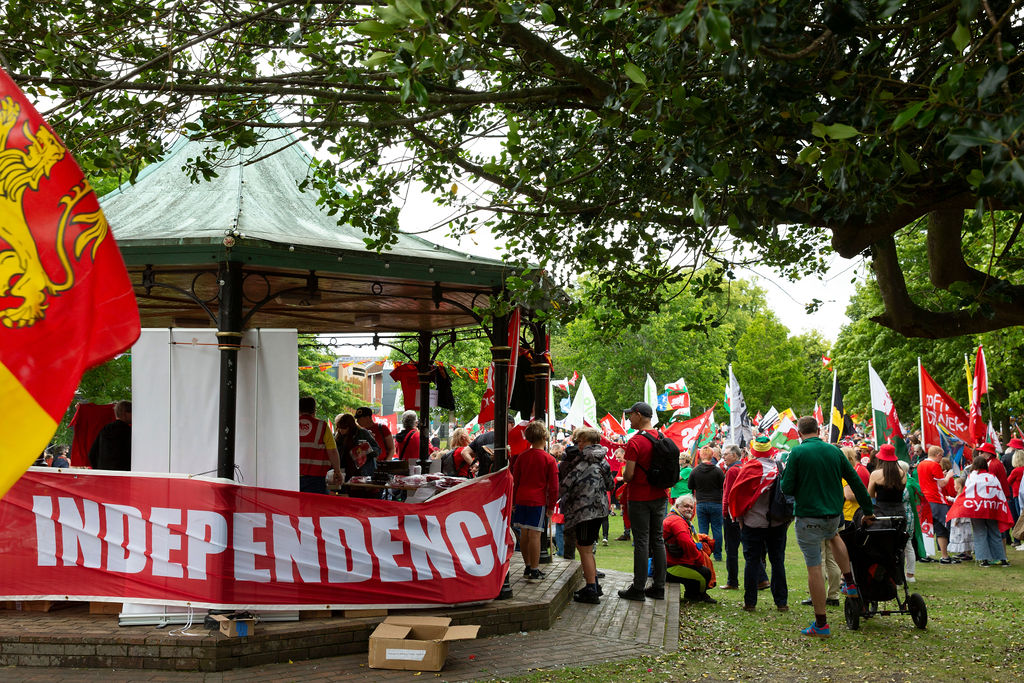WALES
Wrexham’s march showed that none of the momentum has been lost from the independence movement

Ifan Morgan Jones
Back in 2019 the Welsh independence movement held a series of three huge marches, in Cardiff, Caernarfon and Merthyr Tydfil.
The sheer size in thousands of those who attended, and the passion and positivity generated by these events, where truly historic in a Welsh context.
In a nation defined more for its political quietism, which has tended to reserve passion for the rugby pitch, this was a historic turnaround.
And then it all came with a juddering halt.
First with Covid, which cancelled three scheduled marches in 2020 in Wrexham, Tredegar and Swansea.
Then, despite a surge of members to 20,000, things turned sour within YesCymru itself, with the central committee resigning en masse in the summer of last year.
Yesterday, that long-awaited march in Wrexham finally happened, organised by AUOB Cymru, with support from YesCymru and IndyFest Wrexham.
And there were real questions about whether the momentum that had stalled over the last almost three years would or indeed could be reignited.
Like several other failed Welsh national movements in the past – most famously the CymruFydd movement of the last 19th century – would this one peter out and remain another big ‘what if’ in Welsh history?
Good time
Well, on the basis of yesterday I think it’s fair to say that the passion and dedication to political change that characterised the movement back in 2019 was still there in abundance.
The march for independence in Wrexham very much picked up where Merthyr Tydfil in autumn 2019 had left off.
The vibrant, feel-good atmosphere here felt a million miles away from the kind of rancour that has characterised the movement on social media in the intervening period.
A big march is essentially the antithesis of social media such as Facebook and Twitter. The latter is all about what drives people apart – into their different political silos and echo chambers.
The aptly named All Under One Banner, like a mixture of a Wales footballing away day and an Eisteddfod, has everyone marching together to the same, literal, drum beat.
You also have to take your bucket hat off to the organisers, as the event also felt like a slicker affair than the previous ones.
In fact, the march itself felt almost incidental to an event that included a fully kitted-out main stage with speakers and huge screens, music, and a number of stalls selling beer, merchandise, books and other goods.
The emphasis was on having a good time, not just making a political point. It was less of a political chore and more of a nice family day out in a new location.
And given the large dent in my bank account made not just by the stalls but all the surrounding shops, I think that before long Wales’ towns and cities will be bidding to host an independence march, rather than putting up a fight as Wrexham Council did.

Success
What negativity there has been about the march has inevitably come online, and has focused on what some claim was a smaller crowd size than previous marches.
Having been present it didn’t feel that way at all. There were around as many people there than the Merthyr Tydfil march, and more than Cardiff.
But one thing is very important to note: Welsh independence marches aren’t a census. They are not an event by which supporters gather in one place for a headcount.
While the size of the crowd in Wrexham showed that none of the enthusiasm has gone out of Welsh independence movement, it wasn’t some kind of official barometer of its appeal.
Polls show consistently that around 25% of Wales’ population would vote for independence. Only a tiny fraction are ever going to turn out for a political rally.
Neither should we compare like for like with other Welsh independence marches. You’re obviously going to get a bigger pro-independence crowd in Caernarfon than Wrexham.
As proudly Welsh as Wrexham is, it’s obvious that some parts of Wales are going to be more fertile ground for the movement than others, for historical, cultural and political reasons.
That the Welsh independence movement managed to attract between 5,000 and 8,000 people – estimates vary depending on who you ask – to the north-east of Wales was a success.
And as Welsh independence marches become the ‘norm’, it’s likely that we’ll see the crowds shrink rather than increase in size, as the number of marches increases and their novelty fades.
Only 1,200 attended a Scottish independence march in Dumfries last month, and Scotland is closer to independence as it has ever been.
Long haul
The challenge for the Welsh independence movement now will be to keep this new momentum going.
The good news for them is that the UK Government seem entirely determined to help them out in that regard, with a series of attacks on devolution making the status quo unviable and essentially forcing a choice between further autonomy or a stripping away of powers.
There will be bumps and scrapes along the way, and many of them beyond the Welsh independence movement’s control – no one could have seen Covid coming, for instance.
But on the basis of yesterday’s march, the movement is not just Yma o Hyd, but yma for the long haul.
No comments:
Post a Comment